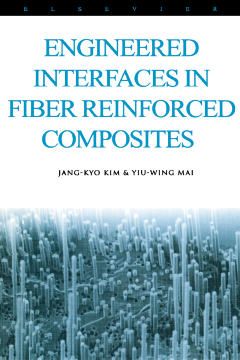
Additional Information
Book Details
Abstract
The study and application of composite materials are a truly interdisciplinary endeavour that has been enriched by contributions from chemistry, physics, materials science, mechanics and manufacturing engineering. The understanding of the interface (or interphase) in composites is the central point of this interdisciplinary effort. From the early development of composite materials of various nature, the optimization of the interface has been of major importance. While there are many reference books available on composite materials, few of them deal specifically with the science and mechanics of the interface of fiber reinforced composites. Further, many recent advances devoted solely to research in composite interfaces have been scattered in a variety of published literature and have yet to be assembled in a readily accessible form. To this end this book is an attempt to bring together recent developments in the field, both from the materials science and mechanics perspective, in a single convenient volume.
The central theme of the book is tailoring the interface properties to optimise the mechanical peformance and structural integrity of composites with enhanced strength/stiffness and fracture toughness (or specific fracture resistance). It deals mainly with interfaces in advanced composites made from high performance fibers, such as glass, carbon, aramid, ultra high modulus polyethylene and some inorganic (e.g. B/W, A12O3, SiC) fibers, and matrix materials encompassing polymers, metals/alloys and ceramics. The book is intended to provide a comprehensive treatment of composite interfaces in such a way that it should be of interest to materials scientists, technologists and practising engineers, as well as graduate students and their supervisors in advanced composites. We hope that this book will also serve as a valuable source of reference to all those involved in the design and research of composite interfaces.
The book contains eight chapters of discussions on microstructure-property relationships with underlying fundamental mechanics principles. In Chapter 1, an introduction is given to the nature and definition of interfaces in fiber reinforced composites. Chapter 2 is devoted to the mechanisms of adhesion which are specific to each fiber-matrix system, and the physio-chemical characterization of the interface with regard to the origin of adhesion. The experimental techniques that have been developed to assess the fiber-matrix interface bond quality on a microscopic scale are presented in Chapter 3, along with the techniques of measuring interlaminar/intralaminar strengths and fracture toughness using bulk composite laminates. The applicability and limitations associated with loading geometry and interpretation of test data are compared. Chapter 4 presents comprehensive theoretical analyses based on shear-lag models of the single fiber composite tests, with particular interest being placed on the interface debond process and the nature of the fiber-matrix interfacial bonding. Chapter 5 is devoted to reviewing current techniques of fiber surface treatments which have been devised to improve the bond strength and the fiber-matrix compatibility/stability during the manufacturing processes of composites. The micro-failure mechanisms and their associated theories of fracture toughness of composites are discussed in Chapter 6. The roles of the interface and its effects on the mechanical performance of fiber composites are addressed from several viewpoints. Recent research efforts to augment the transverse and interlaminar fracture toughness by means of controlled interfaces are presented in Chapters 7 and 8.
R.D. Adams
.... The book has an excellent author and subject index. It is well-written and copiously illustrated. Anyone who needs to study interfaces in composites must read this work.
International Journal of Adhesion & Adhesives 19 (1999) 247
A.K. Roy
.... Dr. Kim and Professor Mai have provided an authoritative presentation of this critical area of composite technology in the monograph. The presentation of the material is systematic and contains up-to-date data in composites technology.... all in all, the monograph is a welcome addition to the composites community. It is expected to be beneficial to practising engineers, designers and graduate students, and should serve as a valuable reference book.
Composites: Part A 30 (1999) 1035-1036
